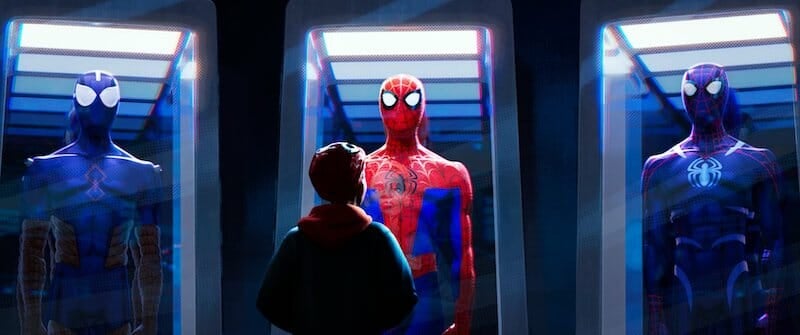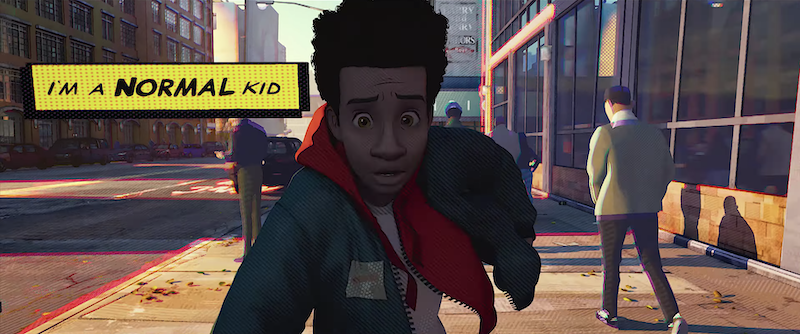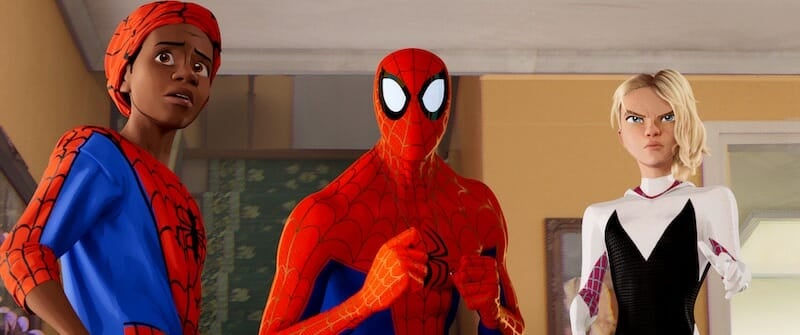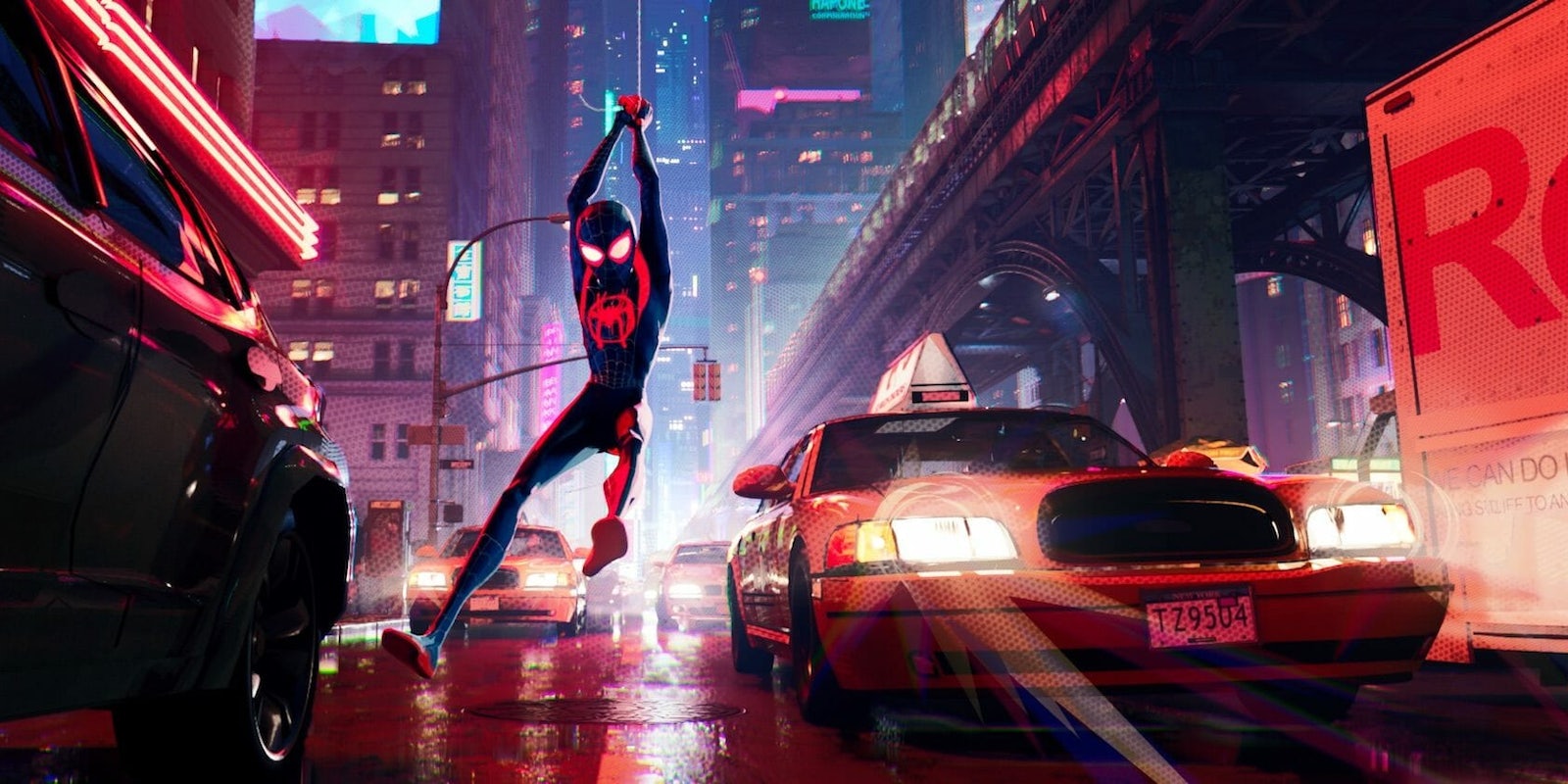Spider-Man’s been on a roll: He’s starred in one of the biggest video games of the year, his enemy Venom headlined a movie of his own, and on Friday, his first animated film hits theaters. If you grew up reading comic books, the film is shaping up to be unlike anything you’ve seen from the superhero movie explosion of the last decade. Spider-Man: Into the Spider-Verse was made utilizing groundbreaking digital technology that allowed the animators to make a movie that’s not just a comic book film, but a film that feels like a comic book.
The animation team appeared at this fall’s Adobe Max conference in Los Angeles to talk about how Photoshop and Illustrator helped them design and craft the film’s stylized look. Following the panel, the Daily Dot sat down with Spider-Verse production designer Justin K. Thompson to discuss how the film’s visual component became a storytelling feature all of its own. You may know Thompson’s work from hits like Cloudy with a Chance of Meatballs, but nothing will prepare you for the visual feast found in Spider-Man: Into the Spider-Verse.

Daily Dot: As a comic book nerd, the trailer for Into the Spider-Verse got me excited to see the movie. The animation looked like a comic book brought to life on-screen thanks to little details like the screen tones. Watching the clip during the presentation today, I was happy to see that wasn’t just for the trailer and would be in the whole movie.
Justin K. Thompson: It definitely does show up through the entire picture. There are times when it’s more present and times when it pulls back, depending on what the story moment is. But we try to take advantage of the look and the style and the feel that we’ve created for the film. I don’t think you’re going to be disappointed. There are things we’ve been teasing. A couple of looks that you’ll be really surprised by when they appear.
Daily Dot: Did you start out aiming to make the animation match the feel of comic books or was it something that naturally evolved during development?
Justin K. Thompson: Actually, you know it’s funny. I don’t think we had any idea. Speaking for myself, most of us didn’t have any idea what it was going to look like from the beginning. I knew I wanted to do something completely different. I knew I had to do something completely different. There were too many Spider-Man movies out there already. But also, I think the only way we could have made any statement with this movie is if we broke new ground. So I have to say hats off to the studio. They just kind of gave me the keys and let me drive the car right off the cliff. We didn’t know [where] we were going.
We were kind of building it as we went and we were constantly making mistakes and constantly iterating and constantly trying things and failing. And then trying new things. And it became a long difficult process of figuring out what worked because we were doing things that we hadn’t seen before and hadn’t seen other people do before. The amazing artists at Imageworks, the visual effects supervisor Danny Dimian, they had to invent from whole cloth so many brand new techniques for this movie. They were just tireless and imaginative and amazing in how they went about it. So everything you see in there is an experiment that we just sort of eventually said: “I think that part of the experiment works!” And it just kept getting bigger and bigger as it went.
“We were finally getting the chance to do something different”
Daily Dot: Was there a comic style that you tried to emulate that just didn’t work or it didn’t translate?
Justin K. Thompson: I don’t think there was anything that that didn’t work. I think it was just a matter of finding the best way to pull it off … we would often tell ourselves, “let’s do this one.” I don’t want to give any spoilers away, but we might for a scene decide to go more old school or we might decide to go more new school with the comic book style. And in each case, we had entirely different problems to solve. Some of our early experiments didn’t look that great. It wasn’t a matter of something not working. It’s just some things took a lot more work to make them look good. We never gave up though we never tried anything where we said: “let’s not even bother with this because it’s going to be too hard.”
The beauty of the crew that I worked with at Sony Pictures Animation and Sony Imageworks is that every time we all had to do something really difficult that hadn’t been done before, I think it got everybody really excited. What was inspiring about this movie for me as a filmmaker, aside from all the creative challenges, was that everyone had a lot of experience. Everybody kept getting excited to keep going. Every time we saw something new, it just made the next team of artists want to go even farther. That was the real beauty of this process and this movie. I don’t even know if we could ever repeat it again simply because we had so many experienced people. We’d all done the traditional thing before. I think people were so hungry that when things were difficult nobody ever turned away. We were finally getting the chance to do something different, and I think that’s really exciting.
Daily Dot: Something that stood out in the trailers is how each “Spider” has their own world. When you see a clip of Spider-Man Noir or Spider-Gwen or Peter Parker, they come from their own place. I think this is the first time we’ve seen a fully realized comic universe without it being already connected to 17 different movies. Will we get to see those worlds in the film?
Justin K. Thompson: I will neither confirm nor deny any. (Laughter.) But but I feel like I can say we’ve definitely made an effort to give each character their own look coming from their own world. And that’s just one more thing to make this movie so time-consuming and difficult to make. We weren’t just trying to create one look, we were trying to create six at the same time. And I think it was amazing just getting the opportunity to sort of blow the doors off exactly what you’re saying. As a fan of comic books, as someone who’s lived with them my whole life and been obsessed with them my whole life, I always wanted to see this. I mean when I would see the movies it always felt live action.
And don’t get me wrong, a lot of live-action movies are some of my favorite movies. I’m a huge huge fan of Infinity War and I can’t wait for the sequel. But I always kind of felt like you lose a little bit of the craftsmanship and the experience of different artists’ takes on different characters. How different books felt different depending on who was drawing it, whether it’s Frank Miller or Bill Sienkiewicz, whether it was Will Eisner or Dan Clowes in a more indie comic. The fact that these comics all had their own identity and style that fit the personality of the characters is what I loved. I was really excited about the opportunity to try and do that in a movie.

Daily Dot: From the trailers and clips that have been released, it’s been interesting to see how you added elements of comics from speech bubbles to movement lines into the film. Did having the freedom to explore those options make you approach the storytelling in a different way than you would in live action?
Justin K. Thompson: Not that they couldn’t have done it in a live-action movie, but it allowed us to take advantage of the comic book page. The idea of panelization—giving details with multiple images and showing multiple story elements at the same time on-screen via different comic panels. It also gave us the opportunity to use words to tell a story on-screen. Sometimes the characters speak and there are words that match what they’re saying.
Sometimes you’re actually reading the characters’ thoughts. So it gave us opportunities to play with the form of the film itself and be playful with the fourth wall in a way that I think in a live-action film you might not buy quite as much. I think it’s kind of great that we could be playful. Not just take advantage of the style and look of a comic book, but actually, use the sequential narrative form of a comic book. It was definitely a huge part of how we developed the story.
Daily Dot: What did you learn during your experience making Into the Spider-Verse that was different from other animated films you’ve worked on? Would it be easier to have made the film in traditional animation versus digital?
Justin K. Thompson: I’ve actually learned something different from every project I’ve ever been on. What I learned on this project is that, if you can dream it they can build it. Would it be harder or easier to do in 2D or 3D? I don’t know that it’s a matter of one is harder or easier. I think it’s a matter of how they present themselves differently on-screen. What I was excited about with the three-dimensional medium is that 3D animation can be just so much more immersive. I just liked the idea from a storytelling point of view of being able to look out at the world from Miles’ eyes and see what a comic book looks like through a character’s eyes.
In the live-action films often you’re kind of seeing the world as we see it around us, but they just happen to be more fantastic characters in it. This was an opportunity to actually show the world in a way that was truly immersive, where I can really put you down inside. Let you actually experience what it would be to look out from that world. That’s why it wasn’t any better or worse. It was just more interesting to me, the idea of not knowing.

Daily Dot: Who is your favorite Spider-Man villain in the movie?
Justin K. Thompson: My favorite villain in this movie is the Prowler. I think he’s incredible. He turned out to be so much more than I thought he could. Because we basically took a fourth-tier villain, and we made him really scary. I was really excited by that. It was one of the great things about making this movie. You know when they first said “you’re going to make this animated Spider-Man movie with me,” I was really worried.
The last thing I wanted to do was like the Saturday morning version of that. I grew up with Saturday morning cartoons, I love Saturday morning, but I don’t know that I want to watch a movie full of that. So what I got really excited about when we started making it is how they really just let us make these characters as dark as we wanted to. And the Prowler was this character like where’s green and has kind of monkey paws. He’s kind of silly. He’ really isn’t that interesting.
But we had the opportunity to actually make him a serious scary villain who was a real nemesis for Miles. I think that’s why he’s my favorite villain in the movie. I think he’s really successful at being terrifying for a 13-year-old boy. That’s what it is, it’s like “What would scare a 13-year-old boy?” We’ve made this really scary dude who comes at him with, like, metal claws and a faceless mask of evil going after him. Just trying to kill him the whole movie. It’s kind of amazing.


